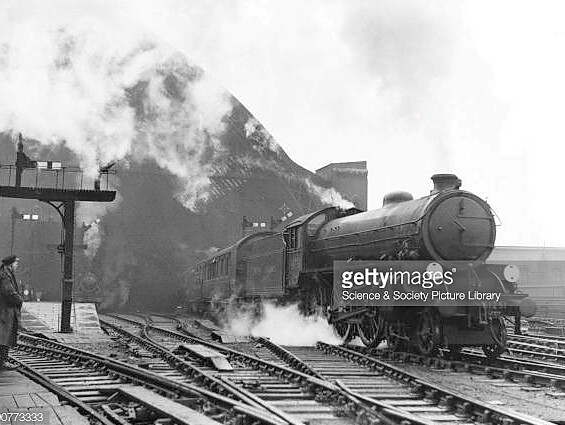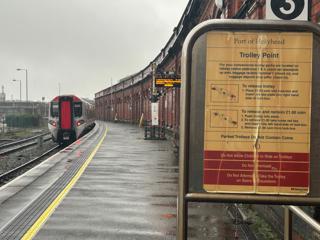One of the best things about writing books is that you get to read books. Researching The Sixties Railway, it was only natural that I’d revisit Gerry Fiennes’ classic I Tried to Run a Railway (1967).
As I read, I was reminded of the famous lesson that ‘when you reorganise, you bleed’. What I’d forgotten, however, was that this was not Fiennes in his own voice, but Fiennes recalling the training he’d received.
Its pertinence was sharpened by the changes he saw during the ‘Beeching revolution’, which mopped up management, led to the closure of some 6,000 route miles, and sped the abolition of steam. For Fiennes, it all got a bit too much, and if he hadn’t been sacked for the tone of his tome, he’d set his heart on retirement by 1971 anyway.
But, of course, the railways have always reorganised: when the Liverpool & Manchester was absorbed by the Grand Junction in 1845; when it too became part of the London & North Western the following year; when over 100 companies were ‘grouped’ from January 1 1923; and when the resulting ‘Big Four’ were nationalised from January 1 1948.
Once taken into public ownership, the system was divided into six regions (Eastern, London Midland, North Eastern, Scottish, Southern, and Western), above which sat an executive - one of five that answered to the British Transport Commission (BTC).
The latter had been established to provide “an efficient, adequate, economical and properly integrated system of public inland transport and port facilities within Great Britain for passengers and goods”.
The former were all about delivering that goal, making it work - which they did… for a while. Yet their methods would come under increasing scrutiny in the years ahead, their reorganisation (and reorganisation again) driven most often by governments seeking to stem what was usually referred to as “the drain on the public purse”. Such would prove to be their ultimate demise.
After nationalisation nothing much changed at first - old logos remained on old locos, and business carried on largely as before. But as operating costs increased and passengers began to prefer their Morris Minors and Austin A30s to the train, BR’s surplus started to become a deficit.
Unhappy with how the figures were falling (and with the BTC’s over-bureaucratic structure), Winston Churchill’s third administration of 1951 produced a Transport Act two years later that did away with the Railway Executive and allowed the Commission direct contact with the regions, which suddenly found themselves with new powers.
This reorganisation had an unintended consequence (as many do), in that it led to an unnecessary proliferation of diesel multiple units being designed, with orders being placed to local specifications (although onlookers often marvelled at the surface veneer, some named trains featuring a restoration of liveries that recalled the Big Four days of yore).
By the end of the decade, the Government was again unhappy with the figures, it being clear to most that the cost of the mid-50s Modernisation Plan was spiralling ‘out of control’.
In 1960, Prime Minister Harold Macmillan thus told the House of Commons that “the railway system must be remodelled to meet current needs, and the Modernisation Plan must be adapted to this new shape”.
In what might have seemed an odd marriage, Macmillan (a former director of the GWR) put his faith in Ernest Marples (a road-engineering contractor involved in motorway construction). To avoid any conflict of interest, the new Transport Minister divested himself of his shares in the Marples, Ridgeway company (to his wife, as it turned out). In the years ahead, he would be accused of impropriety and much more. Either way, he certainly shared the ‘pro-road’ stance of his colleagues and the country at large.
Marples lost little time in appointing a special committee - headed by the chairman of Tube Investments Sir Ivan Stedeford. Among other things, this committee felt that BTC thinking had focused too much on engineering matters. Its proposals therefore led to the cancellation of some electrification schemes (including the Coventry avoiding line), the reversal of the decision to build a flyover at Colwich, and the scrapping of centralised signalling on the Nuneaton-Crewe route.
The chairman of the BTC - by then General Sir Brian Robertson - criticised the cuts, commenting on the “chasm of difference” between his view of the railway as a public service and the Government’s idea of it as a mere transport competitor. But Robertson was due to retire at the end of May 1961, and the appointment of a Stedeford Committee member as his successor was a clear sign that Whitehall meant to follow a more commercial path...
As a director of ICI, the cigar-smoking Dr Richard Beeching had just the sort of sharp business brain that Marples sought, although such virtues came at a price. Part of the deal was that Beeching’s ICI salary would be matched - this brought him £24,000 a year, £14,000 more than Robertson and £10,000 more than the Prime Minister. However, for this he was expected to deliver a solution to a problem that had persisted since the 19th century - making the railways pay.
Beeching knew this issue could only be addressed after deep analysis of the figures. By the end of 1961, he’d mandated a thorough study to assess which traffic ran at a profit, which ran at a loss, which lines made money, and which existed only through subsidy.
He also set about simplifying Robertson’s complex management structure of ‘generals’, committees and sub-committees, opting to recruit private sector experts in a move to bring financial (as opposed to military) discipline to the Commission.
Further simplification came with the 1962 Transport Act, which abolished the BTC and established a British Railways Board (BRB), with powers to set passenger fares and more freedom with freight rates than hitherto.
Beeching became its first chairman on January 1 1963. Two months and countless cigars later, Her Majesty’s Stationery Office published The Reshaping of British Railways, which set out Beeching’s plan to put the railway ‘in the black’ by 1970.
History would show that the doctor’s remedies - the line closures, the focus on block freight workings, and so on - only managed to contain BR’s deficit. Furthermore, by 1968, the political landscape had changed such that Harold Wilson’s Labour government was seeking to support lines that were unprofitable, if they were socially desirable.
That year’s Transport Act - the fourth major piece of railway legislation since the war - therefore not only wiped out BR’s debt of £153 million, it also established Passenger Transport Executives (PTEs) in and around Greater Manchester, Glasgow, Merseyside, Tyneside and the West Midlands.
The idea was that the PTEs would co-ordinate local bus and rail services, ‘purchasing’ the latter from BR on a contract basis. Grants were also available for the ‘social’ railway, including £400,000 for Paddington-Oxford services, £2.5m for Glasgow North and South suburban services, and £9m for Southern Region commuter traffic.
All well and wonderful, but the tides ever do change, and within five or six years more new Whitehall brooms were seeking to reduce the subsidies provided to fund these loss-making services, and to cut the level of investment.
Regarding the latter, the BRB’s Annual Report for 1972 pointed out that “in terms of capital investment for renewal, research, development and improvement, the railways’ share has not been comparable with the millions poured into other forms of transport”.
New motorways and trunk roads, it went on, “represent a national investment every year more than five times greater than investment in British Rail, and even then most of the railway investment is to keep the system going”.
In 1974, another new Labour government brought in a new Railways Act which reduced BR’s capital debt from £438.7m to £250m and offered financial aid to businesses for setting up private sidings.
It also replaced the individual payments for passenger services brought in by the 1968 Act with one Public Service Obligation (PSO) grant. This was a vital step forward in the financial relationship between the railway and the Government, giving new security and self-respect to the management and helping to safeguard BR’s regional passenger business. Of course, it didn’t last, and by 1977 the Government had decided that the whole of the freight business and Inter-City should pay their way, even if other parts of the passenger business were to receive aid.
What might be deemed the ultimate solution had been hinted at after the 1979 General Election, at which Labour had been ousted by the Conservatives following a series of strikes over a public sector pay freeze imposed to control inflation.
Under the chairmanship of Sir Peter Parker, the BRB had realised that there would be little chance of Margaret Thatcher’s regime investing in rail unless something was done to increase productivity. With this in mind, that November it published Challenge of the ’80s, which outlined its aim to develop the railway’s commercial strengths, but also stressed the need to reform the operation and manning of trains, terminals and engineering establishments.
The upshot was that on January 4 1982, the railway’s commercial undertaking was divided into separate elements. Freight and parcels had always been seen as distinct entities, and these naturally formed two of the new sectors. On the passenger side, Inter-City was taken out first, after which London commuter services were grouped to form London & South East (later Network South East). Everything else became Other Provincial Services (later renamed Provincial, and later still Regional Railways). The last two were the ‘social railway’, requiring continuing support for the provision of socially essential services in the capital, in the great conurbations, and in rural areas.
Before this, the five Regions (the Eastern and North Eastern had become one in 1967) had been responsible for marketing, operations, engineering, finance, investment and personnel (as it was still called back then). The General Managers had control of these areas, although the fact that the markets served cut across the Regional boundaries meant that most of the financial responsibility resided with the Board.
Sector management would place managerial responsibility on one director, without changing the organisation unduly and without incurring crippling administration costs. Indeed, it would put BR on more of a business footing than even Beeching had envisaged, with each Sector responsible for sponsoring track, signalling and rolling stock investment, along with the modernisation of stations and so on.
In time, each Sector would develop its own identity, but the main idea was to allow their directors to keep a close eye on running costs and overheads with a view to cutting subsidy, creating confidence and building the case for investment.
It sounded like the perfect solution to BR’s problems, although some managers remembered (as Fiennes had remembered) that companies bled when reorganised, and feared that fragmentation would erode the clear chains of command and communication essential to safety.
Soon after the process began, a magazine article commented on BR’s “state of revolutionary change” and ran an interview with David Kirby, London & South East’s director who also happened to be the General Manager of the Southern Region.
Kirby, who had joined BR as a management trainee in 1954, rose to lead the company’s shipping division (Sealink) before his move onto dry land. Dodging a quip about “reprimanding himself in the style of Basil Fawlty”, there was much talk of “balance” and Kirby’s unique position ensuring that his feet stayed on the ground.
Reading the piece now, there can be no doubt that Kirby’s thinking was ‘market-led’, which of course was the whole point of the exercise. But although he would stay at the Southern’s regional headquarters at Waterloo, his counterparts remained at the Board’s home of 222 Marylebone Road. And it was from here - in April 1982 - that BR Chief Executive Bob Reid asked the Sector Directors to develop business plans, review and challenge investment, and focus on service cost reduction.
Soon, though, there would also be the little matter of the Serpell Report to fend off. Sir David Serpell was a former member not only of the Stedeford Committee, but also of the BRB. His own committee’s report - Review of Railway Finances, published in January 1983 - was critical of BR management, aspects of its ticketing policy and engineering costs. It also castigated the Board for being over-optimistic in its appraisal of “high-risk” projects such as the Advanced Passenger Train, and concluded that line closures would be needed if subsidies were to be “lowered substantially”.
To illustrate the point, the committee presented six network options, from a ‘high-investment’ version consisting of the existing 10,370 route miles (less a planned reduction of 300) to the ‘Beeching-like’ Option A, which assumed a network size of just 1,630 route miles.
Many of Serpell’s findings were hardly revelations - they were freely admitted by the Board, whose members spoke with unguarded self-criticism in the hope that something supportive might emerge. Instead, the report seemed to argue against investment, failed to consider service quality, and did not acknowledge reforms that were already in hand such as substantial staff reductions and the installation of automatic level crossings.
The BRB shunted the whole thing into a siding by nudging the media towards Option A and the threat of commuter fare increases, and by publishing a formal response which (while accepting that improvements could be made in engineering and government interaction) condemned the report as “disappointing, inaccurate, implausible and misleading”.
Shelved pending the June 1983 General Election, the Serpell Report quickly lost all credibility, although Parker would later write that it had at least “cleared the air”. In time, it would also give BR the impetus to pursue efficiency and ‘firm up’ its investment management practices.
By then, however, BR would have a new chairman. Parker knew the next phase of BR’s development had to be led from within, and Bob Reid, who had joined the London & North Eastern Railway as an apprentice in 1947, was the ideal candidate. Parker, who laid the foundations of Sector management and fought hard for investment in the Advanced Passenger Train and electrification, finally left BR in September 1983.
Serpell had welcomed sectorisation, but doubted it would work without the Sector Directors being afforded the appropriate level of authority. But so it came to pass - as the 1980s wore on, more and more power was removed from the Regions, as their managers became increasingly involved with production delivery (although even this had drifted towards the Sector Directors by 1987).
By this time, the Western Region had moved to Swindon and the London Midland to Birmingham, the latter move spelling the end of 222 Marylebone Road. But there was more change to come.
In September 1988, the Board debated future organisational development and opted to enhance Sector control further. The following year, a study by consultant Coopers & Lybrand recommended that British Rail simplify and decentralise on business lines. The result was the Organising for Quality initiative (OfQ).
This name had been coined by London Midland General Manager Ivor Warburton, and led to a greater focus on business-led ‘profit centres’ within the Sectors.
By April 1991 the Scottish, Anglia and Southern had been reorganised, with the Scottish (by now known as ‘ScotRail’) having been identified as a possible profit centre of Provincial, for example. The general managers of Southern and Anglia were to report to Chris Green as Director Network SouthEast (formerly Kirby’s old domain), and six profit centres would be formed to cover the routes in both.
Naturally, the biggest and most complicated region - London Midland - was left until last, although Colin Clifton (then Area Safety Adviser at LM Watford and now Head of Safety and Environment at Southeastern) recalls that “change was in the wind early in 1991”. Indeed, it was around this time that Area Manager Michael Holden left to become Production Director for the new South West Division of Network SouthEast (NSE).
“The DC lines, then branded as ‘North London Lines’ and the ‘Grand Union’ services to Northampton, Rugby and Bedford, were already the main focus of attention,” recalls Clifton.
This meant that “the transition towards the new North Division of NSE was relatively straightforward”. The NSE team, “who were based at Euston, and also had responsibility for Thameslink at the time, gradually moved north to Watford, with Thameslink being established as a separate Division based in the then newly built Friars Bridge Court on Blackfriars Road along with the South Eastern and South Western Divisions, and (of course) Railfreight Distribution.”
By February 1992, the new organisation was all but complete. Warburton officially took control of the West Coast Main Line ‘profit centre’ of InterCity from April 6.
As Terry Gourvish wrote in British Rail 1974-1997: From Integration to Privatisation, the organisation now “represented the full flowering of the business-led, sector management concept BR introduced on a modest scale in 1982”.
Some critics felt that OfQ unnecessarily fragmented operations and engineering and introduced too much complexity, while many saw it as an excellent manifestation of the virtues of flexibility and focusing on core tasks. For Gourvish, “it offered Britain the best prospects of a more streamlined, customer-oriented, empowered organisation in an integrated form”.
Yet history was not to allow it to bed in and prove itself, for by April 1992 - just as new logos on ties, mugs and letterheads were starting to appear - John Major’s Conservative government was re-elected.
Major’s pre-election promise was to sell BR off. More reorganisation was on the way…
- My grateful thanks to Colin Clifton for his assistance in the preparation of this article.
This feature was published in RAIL 824 on 8th April 2017
















Login to comment
Comments
No comments have been made yet.